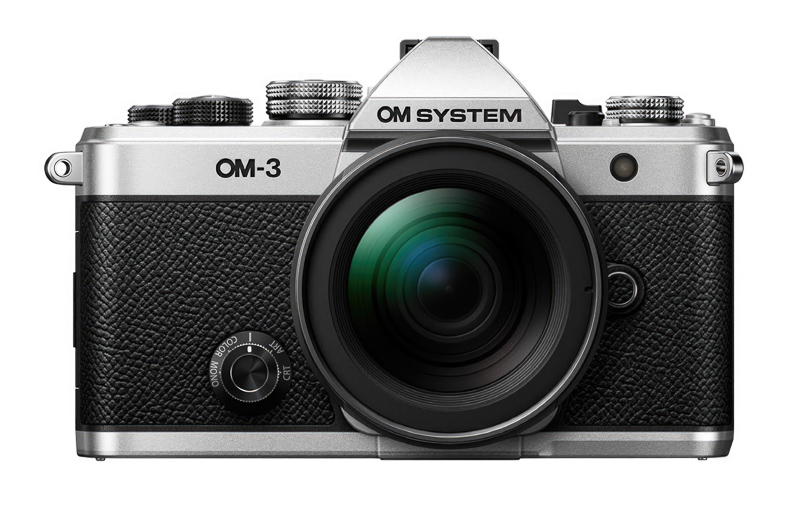
6AM GMT, 6th February 2025
Today, a third OM-3 camera model, in name, at least is revealed, in digital form for once. OM System has revealed their digital OM-3, which pays homage to, and is styled on, the Olympus OM-3 film SLR first launched in 1983, and the almost identical-looking OM-3 Ti (Titanium construction) launched in 1994.
A look at the specification of the OM-3’s internals indicates that the OM-3 uses the same sensor, BLX1 battery, TruePic X image processing engine, and, probably, viewfinder, as the flagship OM System OM-1 Mark II. That means you get the same high-speed 20 megapixel BSI Live MOS sensor, and the same industry leading image stabilisation of up to 6.5 stops. Don’t forget 1053 cross-type PD AF points, AI-trained AF subject detection and tracking, shooting rates at up to 120 frames per second, or 50fps with continuous AF, AF that works for astrophotography, backwards time-travel by up to 70 frames Pro-Capture shooting, and more.
But it’s the packaging of the OM-3 that is radically different.
The OM-3 is unashamedly retro, eschewing the sculpted shoulders and hand grip of the OM-1. While the late, lamented, digital Olympus Pen F, from 2016, served to remind everyone of the brand’s 1960s heritage, the OM-3 brings us forward to the early 1980s, and even, arguably, the 1970s, the heyday of the original Olympus OM film SLR system.
Apart from the faux pentaprism housing, the top-plate, including the shutter release position, is flat, as is the front profile. Only a film advance lever is gone! Several buttons and controls you would find on the exterior of an OM-2 are missing from the OM-3. As partial compensation there is a front-mounted function mode dial, reminding us of where a self-timer control used to be.
There isn’t a titanium version of this OM-3, but instead a professional-grade lightweight magnesium alloy frame. At 413g, an OM-3 body (minus battery) is around 20% lighter than an OM-2 body. The OM-3 has an impress IP53 rating for resistance to dust and moisture ingress.
In a nod to users potentially wishing to use their retro-style OM-3 in a retro fashion, the OM-3 gets new customisable colour and monochrome profile controls. Just think of how much fun you could have reinventing your favourite colour or black and white film characteristics, and no film or developing and processing costs, to boot.
From the OM-3 official press release:
Customizable Profiles for Unique Artistic Expression
Recreate the look of classic film photography with the OM-3’s intuitive Color and Monochrome Profile Controls.
• Color Profile Control: Adjust the saturation of 12 colors across 11 levels, combined with Highlight and Shadow Control for rich, dynamic tones. Choose from four presets like ‘Standard’, ‘Chrome Film Rich Color’ for deep, dynamic tones, ‘Chrome Film Vivid,’ which provides vivid saturation and rich colors, or ‘Chrome Film Soft Tone’ for light, soft tones.
• Monochrome Profile Control: Apply a combination of up to four effects. Presets include Color Filter effect, Highlight & Shadow Control, Shading effects, Film Grain effect, and Monochrome Color effect for unique black and white images. The following four presets are available: Standard, Classic Film B&W, which makes use of a film grain effect, for striking black-and-white images, Classic Film IR, simulating the look of infrared film, and Classic Film Low Contrast, which tones down contrast for a subtle finish.
These profile controls make it easy for photographers to create a signature visual aesthetic while enjoying the flexibility of the latest digital technology.
Decidedly not-retro computational photography features, including those introduced with the OM System OM-1 Mark II, like the simulated Graduated Neutral Density (GND) filter, are retained.
There had been much hope that OM System would update the flat-top 60s-heritage digital Pen F, launched back in 2016. OM System must surely have been aware of this, but the OM-3 was conceived instead. You could ask, why wouldn’t OM System prefer an OM retro offering? The debate as to whether the OM-3 was the right strategy has already started.
OM System’s price on their own Web Shop, currently, is £2149 for the OM-1 Mark II body-only. The OM-3 has many of the best components of the OM-1 Mark II, for £1699. A kit, bundled with the 12-45 (24-90) standard zoom, is priced £1999.
OM System says you will be able to buy an OM-3 from 27th February.
The official page for the OM-3 on the OM System website is accessible here.